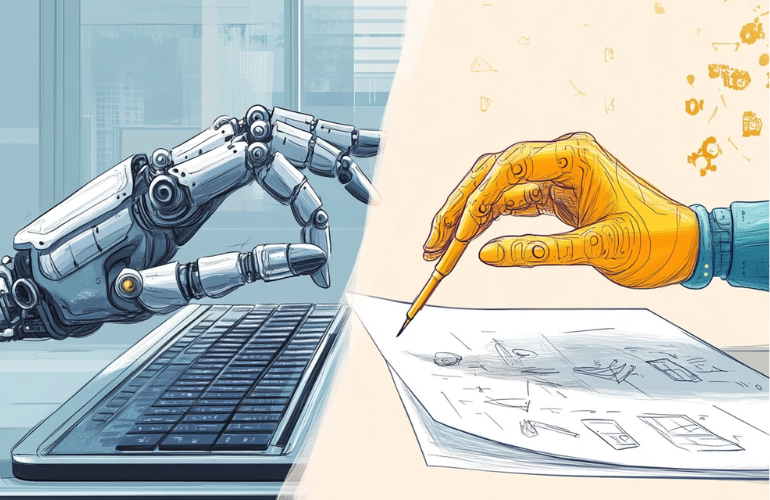As marketers and business owners, we’re always looking for ways to create better content, faster and more efficiently. And with the rise of AI and automation, it’s natural to wonder: will machines replace humans in the content creation process?
The answer is complex. While AI can certainly boost our content creation efforts, human creativity and empathy are still essential to creating content that resonates with audiences. After all, now more than ever, consumers are craving authenticity and connection in a way that AI just can’t replicate.
In this post, we’ll explore the role of AI in content creation, its limitations, and how humans can work alongside technology to create better content.
The Benefits of AI in Content Creation
AI can help us create content more efficiently and effectively. There are things that it can do almost instantly that would take a human a substantially longer time for similar end results. Business owners, marketers, and all content creators should be learning how to use AI as a tool if they want to get ahead.
It’s able to analyze data on audience engagement, search engine rankings, and other metrics to optimize content for better performance. It’s also able to use that data to quickly come up with content ideas and make quick “research”-based edits.
On the topic of making changes based on research, AI can help with research tasks such as fact-checking, data analysis, and trend identification. It’s able to analyze more data in seconds than humans can in a day, and that can be incredibly beneficial, especially when working with tight deadlines.
AI can also help generate content, such as news articles, social media posts, and product descriptions, based on specific templates and guidelines. It can generate large amounts of content quickly which can give marketers, writers, and artists a headstart on marketing campaigns.
The Limitations of AI in Content Creation
While AI can help significantly with content creation, it still has limitations. It doesn’t replace the need for human content creators, even if some brands try to use it on its own.
AI often struggles to understand the nuances of human language and the context in which content is consumed. Because it doesn’t understand certain features of language such as slang or sarcasm on the same level that a human will, it can easily misunderstand what it’s “reading” and it can output content that seems disconnected from normal human language.
AI is great at generating content based on patterns and trends, but it often lacks the creativity and originality that humans bring to the table. It can’t generate any truly new ideas, and any connections it builds will seem obvious because it is unable to approach a topic with creativity.
AI-generated content also lacks the emotional resonance and empathy that humans can convey through their writing. AI content often feels cold and sterile, even if a prompt asked for more emotion.
Finally, and most importantly, AI content is sometimes simply wrong. As the recent mistake with a summer reading list published in The Chicago Sun Times and the Philadelphia Inquirer displayed recently, AI can generate fake information when left unchecked. This is not a mistake you want to make with marketing content lest you lose your credibility.
The Power of the Human Touch
It’s clear that using AI alone isn’t viable, at least not at this time. The human touch is essential for content that’s accurate and feels genuine. So, what can humans bring to the content creation process that AI can’t?
Humans have the ability to think outside the box and come up with new, innovative ideas that AI may not be able to replicate. Again, AI can not come up with anything new. It scrapes pre-existing information for ideas, and this creates limitations.
Human writers and artists are able to convey empathy and emotional resonance in their writing, making it more relatable and engaging for audiences. AI is unable to do this at the same level as it doesn’t experience or “understand” human emotions.
Humans also have a deeper understanding of the context in which content is consumed, allowing them to tailor their content to specific audiences and platforms based on more than just literal data (which is still important, of course).
The Future of Content Creation
So, what’s the future of content creation look like? We believe it’s a combination of AI and human creativity. AI can assist humans in content creation, providing suggestions, ideas, and optimization recommendations. It can also create outlines and help “fill in the blanks” to speed up the content creation process.
Humans can provide creative direction, oversight, and editing to ensure that content meets the desired standards and resonates with the target audience. There should be no piece of long-form written content that doesn’t have the “human touch” applied to it.
Many business owners want to be able to fully automate the content creation process, but at the moment, this isn’t a viable option. If you want accurate and innovative marketing content that resonates with consumers, the human element is irreplaceable. Let AI make the jobs of marketers and content creators easier.
AI Is Changing the Marketing Landscape
By combining the strengths of AI and human creativity, we can create better content that resonates with audiences and drives results. AI may be the future, but the human touch is what can set your marketing content apart. Learning to work with technology and use it as a tool can be a game-changer for marketers and business owners worldwide.
At Payani Media, our team of marketing experts is ready to help take your business to the next level. While we always stay current with new technologies that can assist us every step of the way, we always bring the personality, creativity, and nuance that only the human touch can provide to every single project.
Ready to work with us? Reach out today to learn what we can do for you.




